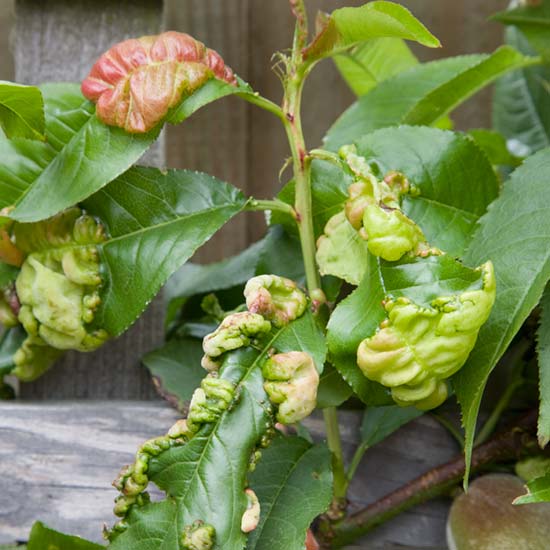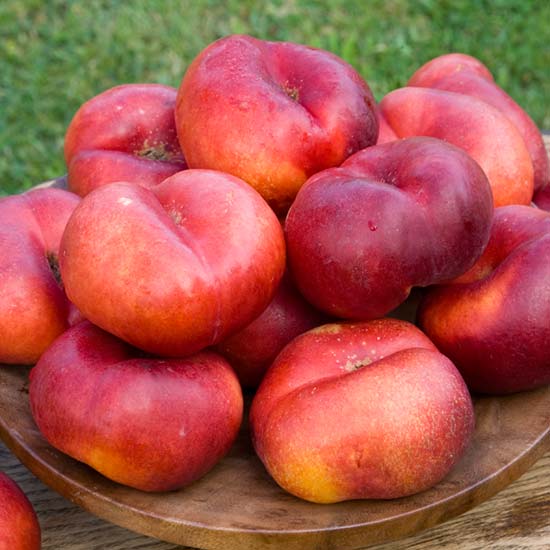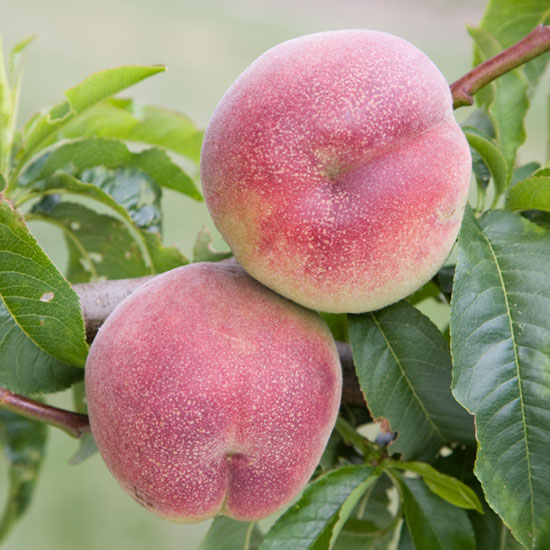I suppose that if asked what the most exotic fruit that we can grow in our gardens is the majority of gardeners would say the peach or nectarine, due to their outstanding quality. Asking the same gardeners about how easy peaches and nectarines are to grow, then the answer would probably be to not try growing them in the garden because they are so difficult to grow! Whilst I would agree that to call peaches and nectarines exotic is a very fitting accolade, nothing could be more untrue in saying that they are hard to grow. Indeed the very opposite is true if attention is paid to planting and growing conditions.
Before I start, I want to nail down fallacies concerning nectarines. I have read that nectarines are the result of a cross between a peach and a plum, that they are unreliable sports or even that they resemble peaches but bear no real relation to them. None of these statements have any truth in them whatsoever – nectarines are simply smooth skinned peaches and botanically they are the same – they all originated from the same species prunus persica. Nevertheless it is usually found that nectarines do not grow as large as peaches. It is also often said that nectarines are a little more tender than peaches and perhaps need a little more warmth but this is not something that I have ever found.
Peaches and nectarines are natives of China despite their botanical name suggesting that they originated in Persia. Peaches, in particular, were recorded as being cultivated in China some 4000 years ago and have always been regarded with high regard both as a symbol of long life and immortality and as a potent force against demons! Although the Romans are reputed to have imported quantities of this fruit into England it was not until the early thirteenth century that they were recorded as being grown in England. However, once introduced they quickly became very popular and as early as 1676 John Rea listed 35 varieties of peach and in 1826 the Horticultural Society listed 224 peaches and 72 nectarines in their collection of fruits at Chiswick. Many of the peaches and nectarines that we know today were bred in the nineteenth century by famous nurserymen such as Thomas Rivers and Laxton’s and included varieties such as Early Rivers, Lord Napier, Sea Eagle, Duke of York, Humboldt and Peregrine. It was boasted by these nurserymen that the varying varieties of peaches and nectarines meant that they could have a season from the beginning of July until the end of October.
Peaches and nectarines are constantly being bred and improved – none more so than in Canada and the USA where they are very popular indeed. It is a shame that the majority of those grown in the UK today are those varieties bred so many years ago and little experimentation has occurred since.
Having told you that peaches and nectarines are easy to grow, it is important nevertheless to recognise a number of ground rules. Perhaps the most important point to note about these fruits is that despite their exotic background the trees themselves are hardy and cold weather will not harm them. However, because peaches and nectarines flower early in the year – usually in March – the blossom is very susceptible to fatal damage due to freezing caused by frosts or freezing winds. To be sure of a good crop and to minimise damage during frosts and periods of cold winds, I would always advocate growing peaches and nectarines outdoors as fan trained trees against walls – south or west facing where they will receive plenty of sunshine during the day and retained heat at night. Grown in this way they are easy to cover when cold weather is forecast.
Although peaches and nectarines can be grown as bushes in the warmer parts of the country – and indeed they have in the past been commercially cultivated in this way – it can be a risky business (it can particularly annoying to lose a crop when growing a single tree) and to my mind they are best managed when all of the fruits can be easily seen, as on a fan trained tree which means easy thinning and good exposure to the sun for ripening. It is possible to grow bush trees in pots on patios and suitable dwarf varieties are becoming available – I will note a few of these later – but the pots must be taken under cover in times of frost and cold wind and taken out again in warmer weather to allow pollination unless this is done by hand. Incidentally, peaches and nectarines are self-fertile so a single tree will suffice although as with the majority of other self-fertile fruits, they will crop better if there is another variety of the same fruit nearby.
Peaches and nectarines can also be grown as fan trees under glass, which was very common in the past. Not only did this provide for good cropping in all parts of the country – depending on the heat available – but it also allowed for earlier cropping than could be achieved outdoors. Although this was ideal for the Victorian kitchen gardeners I would suggest that your greenhouses are best used for other crops unless you are in a cooler part of the country.
The second ground rule is thinning the fruits. A well pollinated peach or nectarine will set a very large number of fruits and it is vital to thin these out if good size fruits are required – which, of course, they will be! The final spacing between fruits should be around 22cm (9in) but I suggest that you achieve this in a couple of stages. Firstly the fruits should be thinned out in late May/early June when they are about the size of a twenty pence piece. At this point all clusters should be thinned to single fruits about 10cm (4in) apart. At the same time remove all fruits growing into the wall or where they are in positions unable to expand. The second thinning should take place around four to six weeks later when they are roughly the size of a fifty pence piece. At this stage peach fruits should be thinned to 22cm (9in) apart and nectarines around 15cm (6in) apart.
The third ground rule is the avoidance of peach leaf curl which is that very nasty disease that causes blisters to form on the leaves of the tree which are first red but later swell up and turn white. Infected leaves usually fall early in the season. Not only is peach leaf curl unsightly but it has been known to spread to the fruits themselves. The constant early fall of the leaves as well as their inability to perform their necessary functions whilst infected can cause a weakening of the tree and poor cropping. The main reason for this disease spreading is dampness during the winter months caused by rain or condensation and this is easily prevented by covering the trees during the winter months. In the case of fan trees this is easily done by erecting a polythene cover over them from the end of November until the end of May, remembering to lift it off during warm days when the trees are in flower. Remember what I said earlier about fan trees being easier to manage! In the case of trees grown in pots, they should be moved under the cover of a greenhouse or conservatory during the same period or if they are grown as outdoor bushes a more ingenious arrangement will need to be devised.
Having considered the above three ground rules what are the best varieties to grow? Let’s consider nectarines first.
Varieties of Nectarine
Early Rivers is one of the best early nectarines which ripens in early to mid-July depending upon the season. It is a roundish nectarine and is usually a large greenish yellow fruit covered almost all over with a scarlet flush. It has a pale yellow flesh which is very soft and it is juicy with an excellent flavour.
Honeykist is considered to be partially resistant to the spores of peach leaf curl. The nectarines are large with a dark red skin and yellow flesh and have a superb flavour.
Lord Napier is possibly the best known nectarine and is another early variety ripening in early August. It has oval fruits which are large in size and are pale yellow covered nearly all over with a crimson/brown flush. The flesh of the fruit is very pale green with a very good flavour. The attractive fruits make it a most decorative tree to grow and it also has the benefit of being very hardy and ideal for cooler parts.
Sauzee King is a new flat nectarine with an attractive red skin, juicy white flesh and a really good flavour. It will crop from an early age.
Snow Baby is one of the new genetically dwarf nectarines which is ideal for growing in a pot or container. The flesh of the fruit is white and it will crop heavily from an early stage.
Varieties of Peach
My first peach is ‘Avalon Pride’, which is of the highest quality and ripens at the end of July/early August. It has large, round fruits which are creamy with a bright red flush. The yellow flesh is very soft, sweet and juicy with a good flavour. This is a good garden variety and is very decorative with good resistance to peach leaf curl. This variety is very hardy and can be grown successfully as a bush tree.
Crimson Bonfire is a purple leafed genetically dwarf peach which produces good crops of dark red fruits with sweet and juicy yellow flesh.
Diamond is another new genetically dwarf peach ideal for container growing. It produces large crops of orange/red skinned fruits with a white melting flesh.
Duke of York is a peach of the highest quality, ripening at the end of July. It has large, round fruits which are creamy with a bright red flush. The flesh is pale green and is very soft, sweet and juicy with a good flavour. This is a good garden variety and is very decorative. It is also very hardy and can be grown successfully as a bush tree.
Hale’s Early is not as early as the name suggests but it should be ripe by the end of July/early August. The fruits are medium in size and pale greenish yellow with a purple/red flush and some mottling in the parts exposed to the sun. The flesh is white or a very pale yellow, often purple near the stone and it is very soft and juicy. The flavour is not as outstanding as other peaches but this variety is very hardy and can produce a good crop outdoors even in cooler springs.
Lacrima is unique for its weeping habit and crops very well producing red skinned, yellow fleshed peaches which cascade down to the ground.
Peregrine is probably still the best known garden peach and is well worth growing as it will grow well in all conditions – I have even had this variety fruiting after frost had damaged the blossom. It is still a popular commercial variety of peach as it is easy to grow and it has a good flavour. The fruits, which ripen in early August, are round, medium/large in size and crimson/red all over in anything other the most concealed conditions. The unusual thing about this peach is that the flesh is almost as smooth as a nectarine and I have heard it described as a nectarine on more than one occasion by a know-it-all! The flesh of the fruits is white, firm, very juicy and has a very good flavour. Well recommended for the garden.
Rochester is another well-known peach and like Peregrine is well suited to the UK climate. This peach has the advantage of flowering quite late and is therefore more suitable for growing in frost pockets or colder areas. The fruits, which ripen in mid-August, can grow quite large and the flesh is yellow and very juicy and in good years the flavour develops very well.
Royal George is a very old variety having been known as long ago as the 18th Century. This peach, which ripens at the end of August is very decorative. It is large, round, perhaps slightly flattened at its top and yellow with a deep red flush. The flesh is pale yellow and is very soft with an outstanding flavour as long as it is well ripened. Although it is very suitable for garden growing, it is perhaps best grown in more southerly gardens as it has a longish growing season.
Sanguine de Savoie is considered to be one of the finest tasting peaches and is a selection from the French wild growing ‘Blood Peaches’. The flesh of the peach is deep red with a wonderful taste and perfume.
Saturne is a flat peach. Although it is unusual in shape it is very sweet and it is said by some to have a taste of honey in it although I have yet to notice this myself. It has a white flesh which is very juicy. A good talking point in the garden, these peaches are very good croppers and are very popular with children.
Gerry Edwards
29th September 2015
Gerry is an experienced amateur fruit grower who is Chairman of the RHS Fruit Group, a member of the Royal Horticultural Society’s Fruit, Vegetable and Herb Committee and also their Fruit Trials Panel. Gerry judges fruit nationally for the Royal Horticultural Society and is also a qualified National Vegetable Society judge.




EXcelent wright up very encouraging to growing nectarines and peaches many thanks Philip.